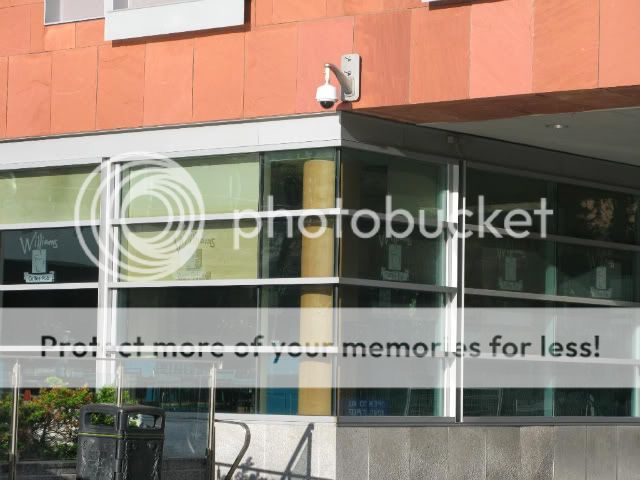If you haven't heard yet, counter-surveillance is the process of performing surveillance of surveillance, whether that be surveillance technology, police or any other form of disciplinary watching.



You will notice these types of cameras all over the exterior of the building. Of course, these are provided with your safety in mind, so why perform counter-surveillance on them? Really, that is up to you.
Counter-surveillance is performed for a number of reasons. One common reason is that many people feel that if the public is going to be subjected to surveillance, they have the right to know about it. By highlighting the presence of surveillance, as in the pictures of cameras offered here, we can map out which spaces are being watched and which are not. This provides advantages both ways. On the one hand, if you need protection, if you feel you need to be in space under observation, then you can get to it. Conversely, if you do not wish to have your image recorded, you can avoid those spaces. While one might think of this as something only criminals desire, it is also something very important to people interested in privacy ethics. Surveillance spaces can blur or define the lines between private and public spaces, and private and public actions.
Probably the most important reason for performing counter-surveillance though is that it can aid in making sure that surveillance is not abused. People often think that engaging in counter-surveillance means you are positioning yourself against surveillance. This is not necessarily true. The safety provided by surveillance gives us all sorts of freedoms. Without it, we would likely not feel safe taking the tour we are now. But if our lives are going to be recorded, especially by people who are in positions of power and authority over us, don't we have the right to record back? To make sure that safety is what is being enforced, not some other motivation, whether personal or political?




You will also find a number of cameras on the building's interior. They are not all documented here yet, but we are working on it. Moreover, Waterloo Watchmen is a collaborative, public project, and so we welcome any counter-surveillance data at: invisibilityisatrap@gmail.com
Why not use the cellphone you are reading this on right now to snap a few counter-surveillance pictures?


Counter-surveillance can also highlight interesting aspects about surveillance that may otherwise seem hidden. For example, in closely observing these cameras, I noticed that the large cases in the middle of each doorway now appear to be empty. If they have been replaced by the smaller cameras on the side, what are they used for?
The answer is implied surveillance. Implied surveillance is a powerful technique, and one of the biggest supposed crime deterrents provided by surveillance technology. The idea is to convince you that you are being watched, whether you are or not. When people internalize surveillance in this way, they are less likely to act in non-desirable ways. Indeed, this is how surveillance cameras deter crime in general - typically they are not being monitored 24/7. Instead it is the threat of being watched and recorded, of being punished later, that provides the deterrent to crime.
Considering that, maybe counter-surveillance can be used to increase the effectiveness of surveillance technology, by highlighting its presence to people who would otherwise have engaged in deviant behaviour.

Get involved in K-W's counter-surveillance movement. Post comments on this blog, submit pictures, discuss it with your friends. We are not trying to end surveillance. That would be a hopeless fight. We are trying to understand surveillance and its many effects. Help us.





























